Analysis of UPS: Recruitment, Leadership Styles, and Teamwork Dynamics
VerifiedAdded on 2020/10/23
|15
|3891
|88
Report
AI Summary
This report provides an in-depth analysis of human resource management practices within United Parcel Services (UPS), a UK-based courier company. The report is structured around four key tasks: the first task focuses on the documentation required for recruitment and selection, including the impact of legal and ethical considerations, and the individual's contribution to the selection process. The second task delves into leadership, examining the skills and attributes of effective leaders, differentiating between leadership and management, exploring various leadership styles for different situations (participative and autocratic), and identifying methods for staff motivation. Task three explores the benefits of team-working, its importance in achieving goals, and its effectiveness in achieving business objectives. The final task addresses performance management, outlining factors involved in planning, monitoring, and assessing work performance, including the creation and evaluation of assessment plans. The report emphasizes the importance of effective recruitment, leadership, teamwork, and employee motivation in achieving organizational success.
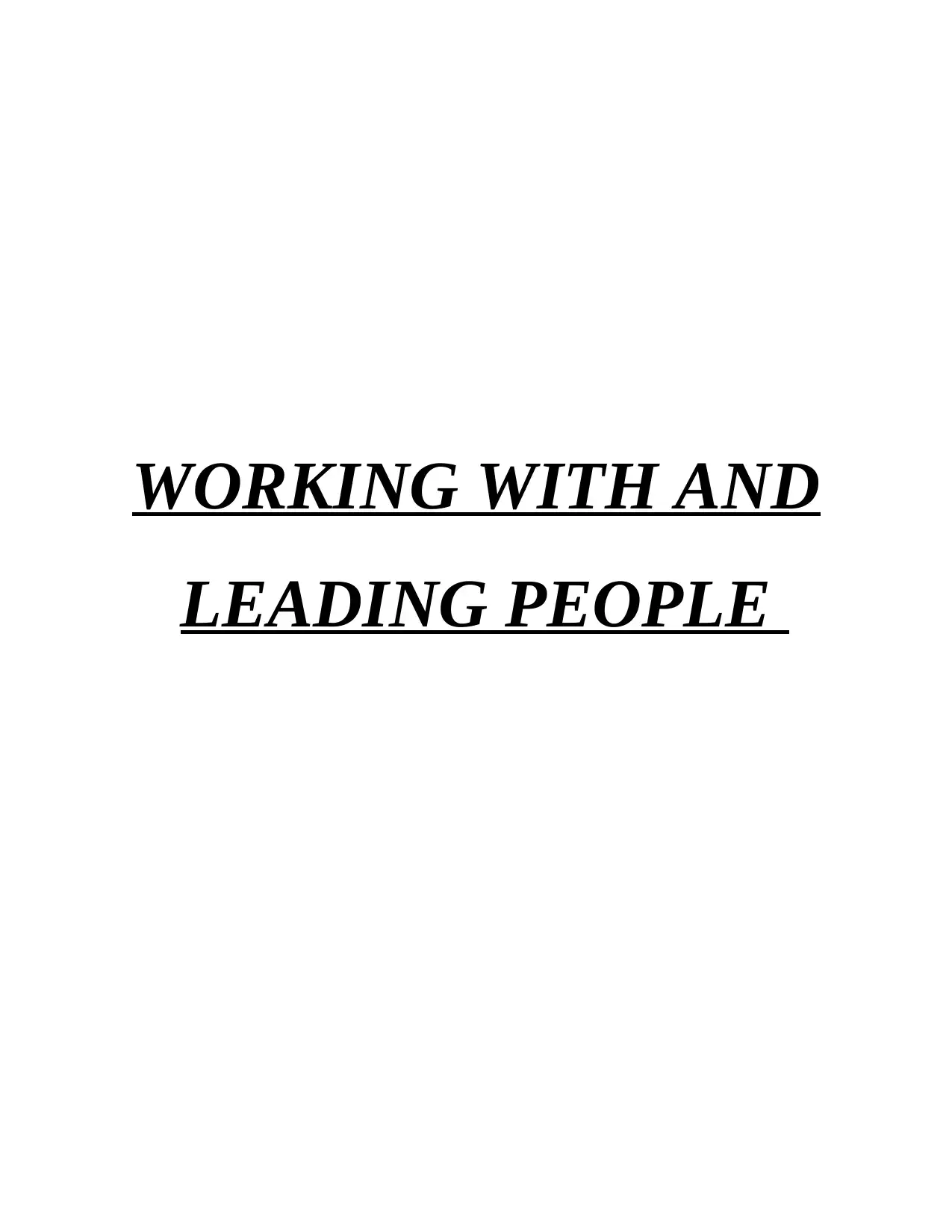
WORKING WITH AND
LEADING PEOPLE
LEADING PEOPLE
Paraphrase This Document
Need a fresh take? Get an instant paraphrase of this document with our AI Paraphraser
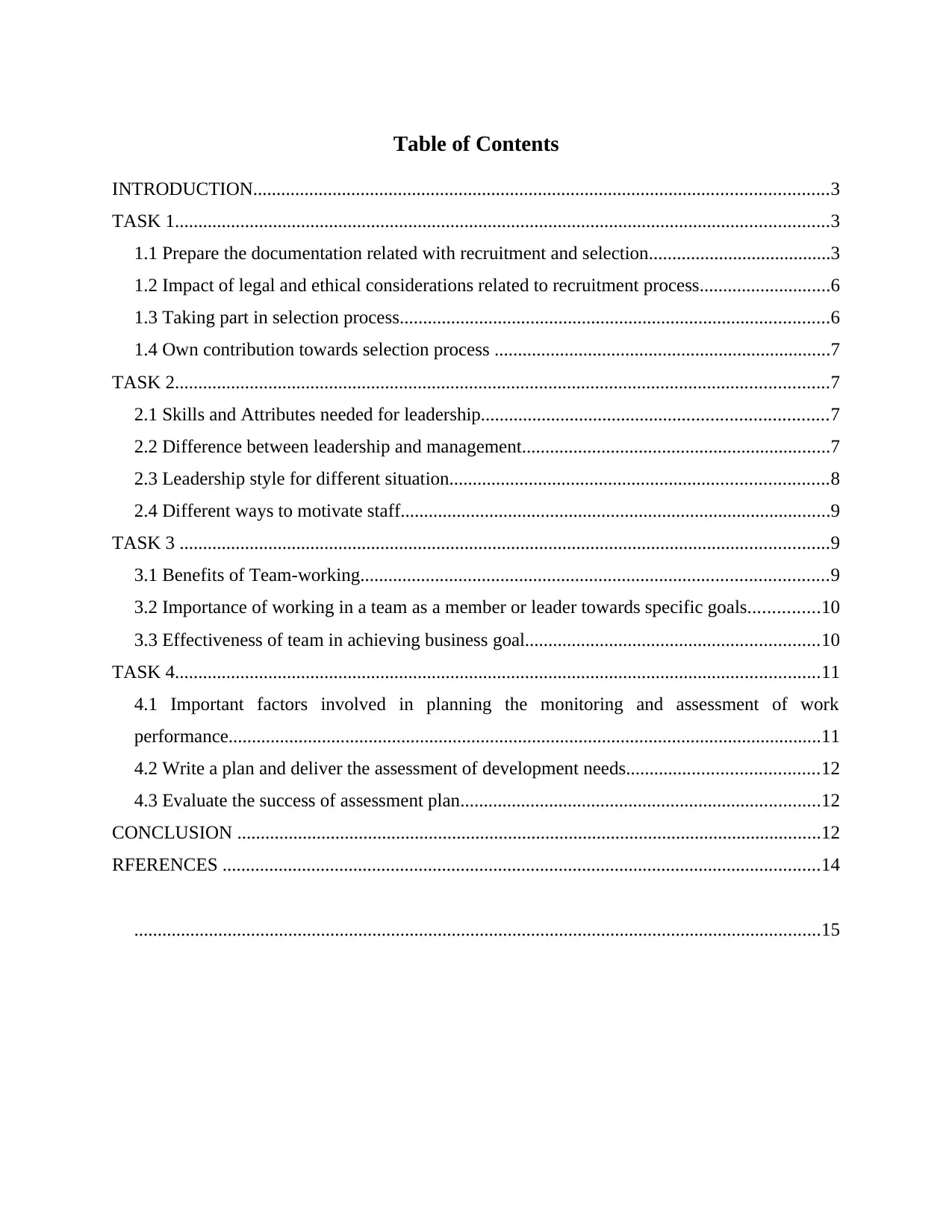
Table of Contents
INTRODUCTION...........................................................................................................................3
TASK 1............................................................................................................................................3
1.1 Prepare the documentation related with recruitment and selection.......................................3
1.2 Impact of legal and ethical considerations related to recruitment process............................6
1.3 Taking part in selection process............................................................................................6
1.4 Own contribution towards selection process ........................................................................7
TASK 2............................................................................................................................................7
2.1 Skills and Attributes needed for leadership..........................................................................7
2.2 Difference between leadership and management..................................................................7
2.3 Leadership style for different situation.................................................................................8
2.4 Different ways to motivate staff............................................................................................9
TASK 3 ...........................................................................................................................................9
3.1 Benefits of Team-working....................................................................................................9
3.2 Importance of working in a team as a member or leader towards specific goals...............10
3.3 Effectiveness of team in achieving business goal...............................................................10
TASK 4..........................................................................................................................................11
4.1 Important factors involved in planning the monitoring and assessment of work
performance...............................................................................................................................11
4.2 Write a plan and deliver the assessment of development needs.........................................12
4.3 Evaluate the success of assessment plan.............................................................................12
CONCLUSION .............................................................................................................................12
RFERENCES ................................................................................................................................14
...................................................................................................................................................15
INTRODUCTION...........................................................................................................................3
TASK 1............................................................................................................................................3
1.1 Prepare the documentation related with recruitment and selection.......................................3
1.2 Impact of legal and ethical considerations related to recruitment process............................6
1.3 Taking part in selection process............................................................................................6
1.4 Own contribution towards selection process ........................................................................7
TASK 2............................................................................................................................................7
2.1 Skills and Attributes needed for leadership..........................................................................7
2.2 Difference between leadership and management..................................................................7
2.3 Leadership style for different situation.................................................................................8
2.4 Different ways to motivate staff............................................................................................9
TASK 3 ...........................................................................................................................................9
3.1 Benefits of Team-working....................................................................................................9
3.2 Importance of working in a team as a member or leader towards specific goals...............10
3.3 Effectiveness of team in achieving business goal...............................................................10
TASK 4..........................................................................................................................................11
4.1 Important factors involved in planning the monitoring and assessment of work
performance...............................................................................................................................11
4.2 Write a plan and deliver the assessment of development needs.........................................12
4.3 Evaluate the success of assessment plan.............................................................................12
CONCLUSION .............................................................................................................................12
RFERENCES ................................................................................................................................14
...................................................................................................................................................15
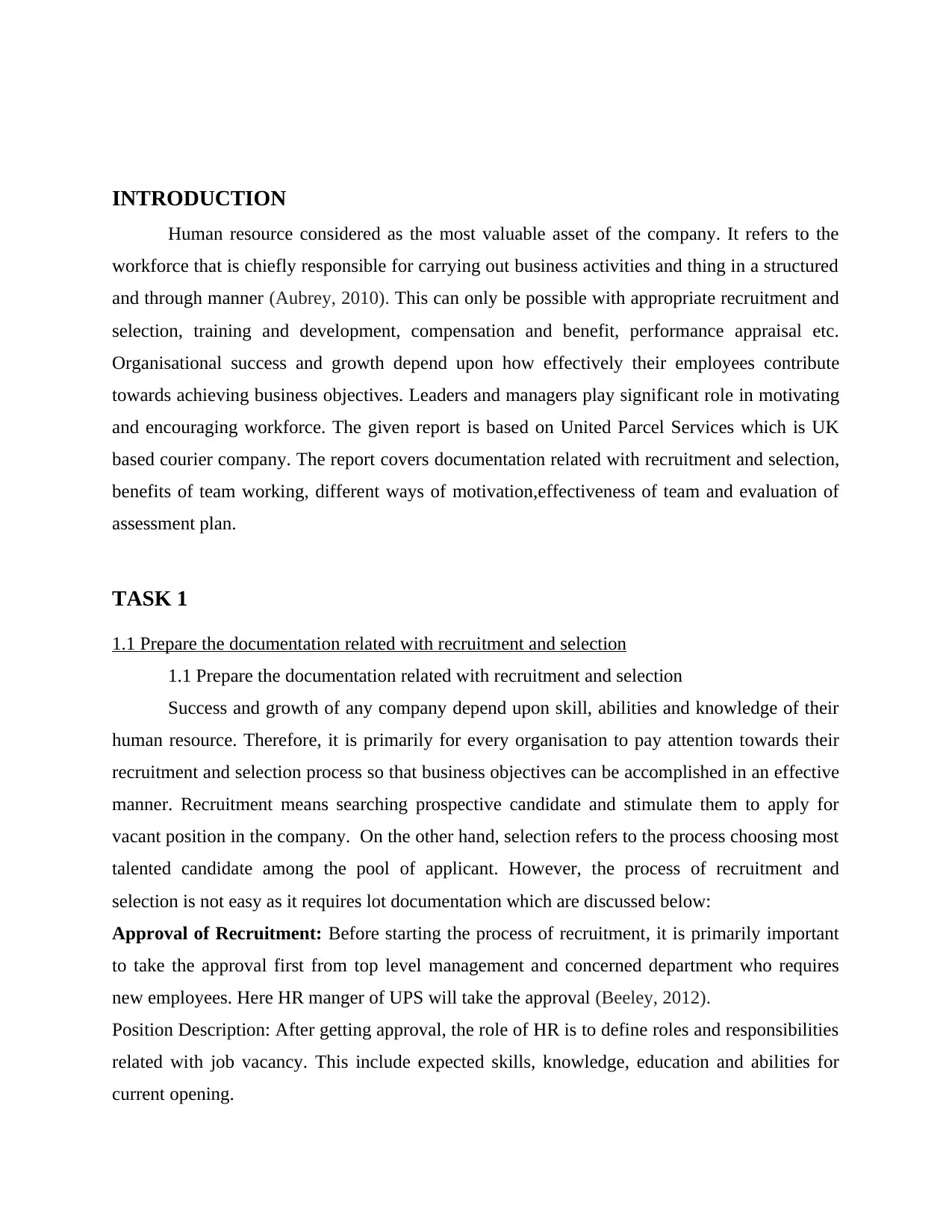
INTRODUCTION
Human resource considered as the most valuable asset of the company. It refers to the
workforce that is chiefly responsible for carrying out business activities and thing in a structured
and through manner (Aubrey, 2010). This can only be possible with appropriate recruitment and
selection, training and development, compensation and benefit, performance appraisal etc.
Organisational success and growth depend upon how effectively their employees contribute
towards achieving business objectives. Leaders and managers play significant role in motivating
and encouraging workforce. The given report is based on United Parcel Services which is UK
based courier company. The report covers documentation related with recruitment and selection,
benefits of team working, different ways of motivation,effectiveness of team and evaluation of
assessment plan.
TASK 1
1.1 Prepare the documentation related with recruitment and selection
1.1 Prepare the documentation related with recruitment and selection
Success and growth of any company depend upon skill, abilities and knowledge of their
human resource. Therefore, it is primarily for every organisation to pay attention towards their
recruitment and selection process so that business objectives can be accomplished in an effective
manner. Recruitment means searching prospective candidate and stimulate them to apply for
vacant position in the company. On the other hand, selection refers to the process choosing most
talented candidate among the pool of applicant. However, the process of recruitment and
selection is not easy as it requires lot documentation which are discussed below:
Approval of Recruitment: Before starting the process of recruitment, it is primarily important
to take the approval first from top level management and concerned department who requires
new employees. Here HR manger of UPS will take the approval (Beeley, 2012).
Position Description: After getting approval, the role of HR is to define roles and responsibilities
related with job vacancy. This include expected skills, knowledge, education and abilities for
current opening.
Human resource considered as the most valuable asset of the company. It refers to the
workforce that is chiefly responsible for carrying out business activities and thing in a structured
and through manner (Aubrey, 2010). This can only be possible with appropriate recruitment and
selection, training and development, compensation and benefit, performance appraisal etc.
Organisational success and growth depend upon how effectively their employees contribute
towards achieving business objectives. Leaders and managers play significant role in motivating
and encouraging workforce. The given report is based on United Parcel Services which is UK
based courier company. The report covers documentation related with recruitment and selection,
benefits of team working, different ways of motivation,effectiveness of team and evaluation of
assessment plan.
TASK 1
1.1 Prepare the documentation related with recruitment and selection
1.1 Prepare the documentation related with recruitment and selection
Success and growth of any company depend upon skill, abilities and knowledge of their
human resource. Therefore, it is primarily for every organisation to pay attention towards their
recruitment and selection process so that business objectives can be accomplished in an effective
manner. Recruitment means searching prospective candidate and stimulate them to apply for
vacant position in the company. On the other hand, selection refers to the process choosing most
talented candidate among the pool of applicant. However, the process of recruitment and
selection is not easy as it requires lot documentation which are discussed below:
Approval of Recruitment: Before starting the process of recruitment, it is primarily important
to take the approval first from top level management and concerned department who requires
new employees. Here HR manger of UPS will take the approval (Beeley, 2012).
Position Description: After getting approval, the role of HR is to define roles and responsibilities
related with job vacancy. This include expected skills, knowledge, education and abilities for
current opening.
⊘ This is a preview!⊘
Do you want full access?
Subscribe today to unlock all pages.

Trusted by 1+ million students worldwide
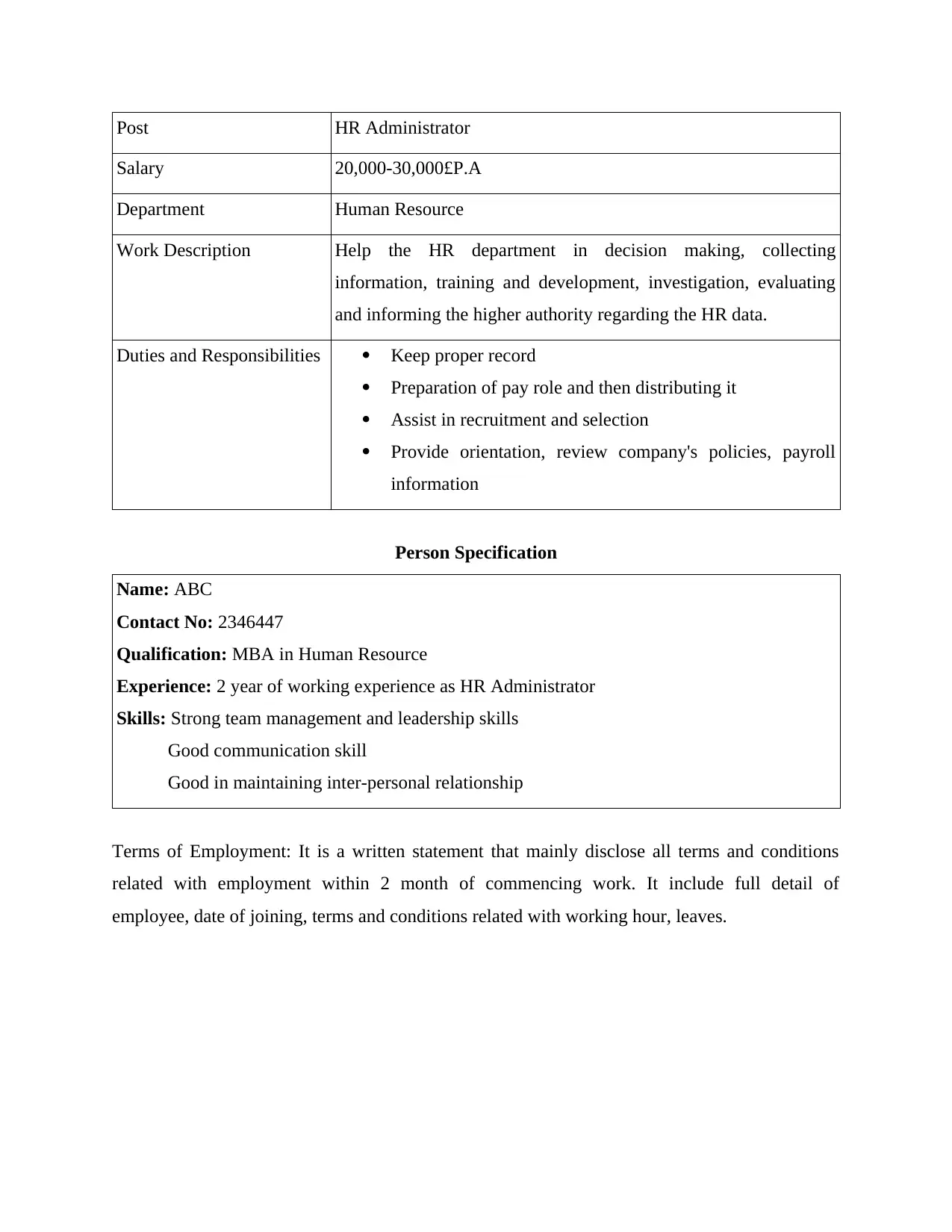
Post HR Administrator
Salary 20,000-30,000£P.A
Department Human Resource
Work Description Help the HR department in decision making, collecting
information, training and development, investigation, evaluating
and informing the higher authority regarding the HR data.
Duties and Responsibilities Keep proper record
Preparation of pay role and then distributing it
Assist in recruitment and selection
Provide orientation, review company's policies, payroll
information
Person Specification
Name: ABC
Contact No: 2346447
Qualification: MBA in Human Resource
Experience: 2 year of working experience as HR Administrator
Skills: Strong team management and leadership skills
Good communication skill
Good in maintaining inter-personal relationship
Terms of Employment: It is a written statement that mainly disclose all terms and conditions
related with employment within 2 month of commencing work. It include full detail of
employee, date of joining, terms and conditions related with working hour, leaves.
Salary 20,000-30,000£P.A
Department Human Resource
Work Description Help the HR department in decision making, collecting
information, training and development, investigation, evaluating
and informing the higher authority regarding the HR data.
Duties and Responsibilities Keep proper record
Preparation of pay role and then distributing it
Assist in recruitment and selection
Provide orientation, review company's policies, payroll
information
Person Specification
Name: ABC
Contact No: 2346447
Qualification: MBA in Human Resource
Experience: 2 year of working experience as HR Administrator
Skills: Strong team management and leadership skills
Good communication skill
Good in maintaining inter-personal relationship
Terms of Employment: It is a written statement that mainly disclose all terms and conditions
related with employment within 2 month of commencing work. It include full detail of
employee, date of joining, terms and conditions related with working hour, leaves.
Paraphrase This Document
Need a fresh take? Get an instant paraphrase of this document with our AI Paraphraser
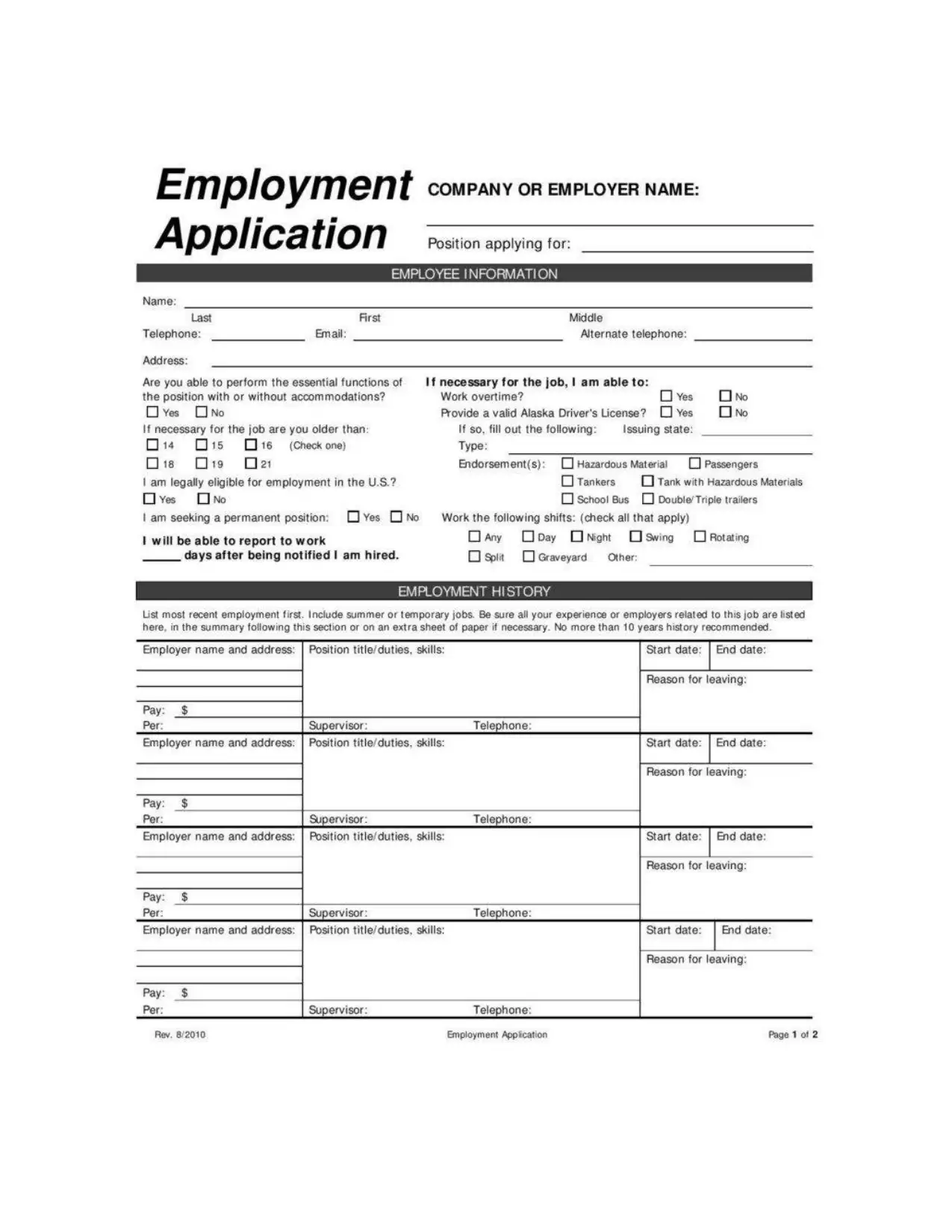
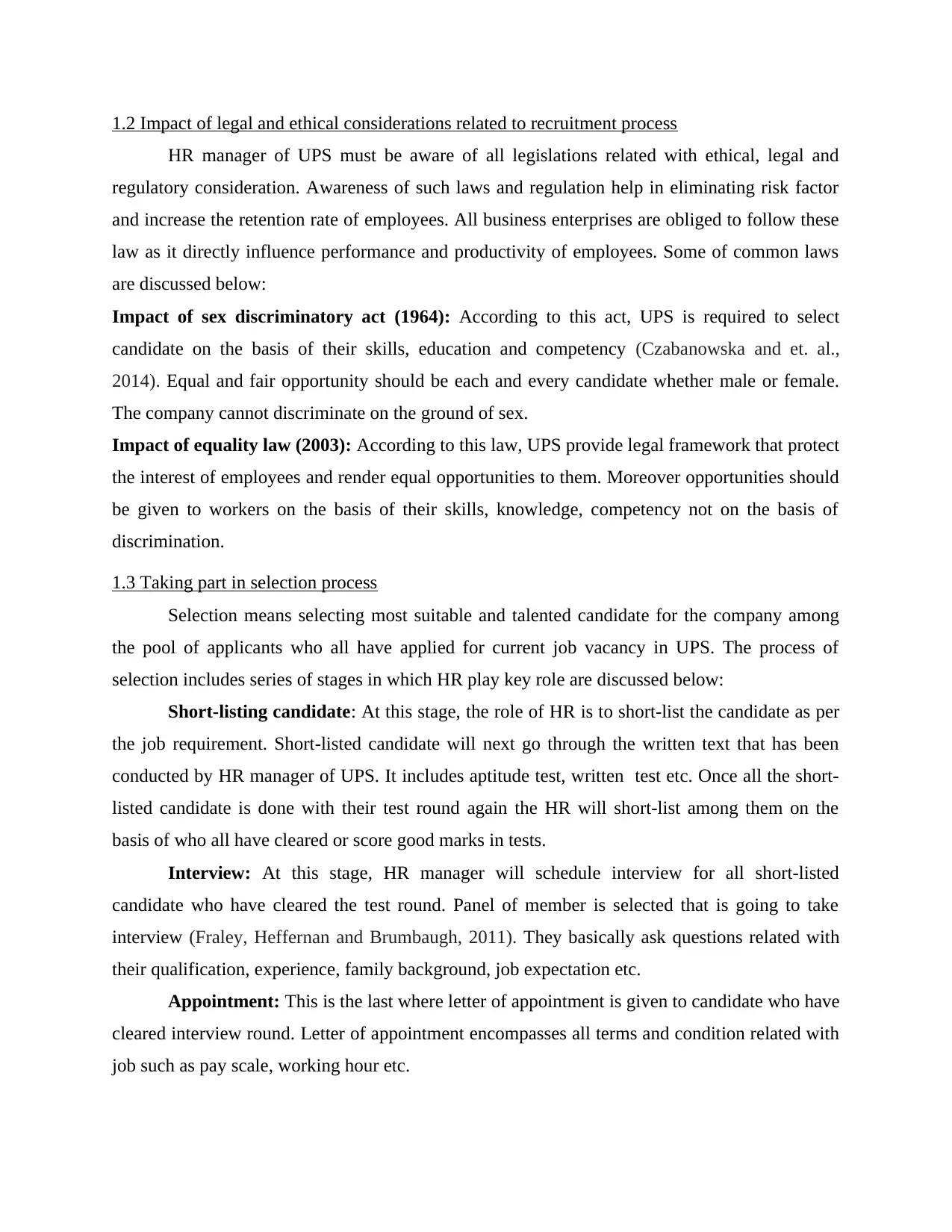
1.2 Impact of legal and ethical considerations related to recruitment process
HR manager of UPS must be aware of all legislations related with ethical, legal and
regulatory consideration. Awareness of such laws and regulation help in eliminating risk factor
and increase the retention rate of employees. All business enterprises are obliged to follow these
law as it directly influence performance and productivity of employees. Some of common laws
are discussed below:
Impact of sex discriminatory act (1964): According to this act, UPS is required to select
candidate on the basis of their skills, education and competency (Czabanowska and et. al.,
2014). Equal and fair opportunity should be each and every candidate whether male or female.
The company cannot discriminate on the ground of sex.
Impact of equality law (2003): According to this law, UPS provide legal framework that protect
the interest of employees and render equal opportunities to them. Moreover opportunities should
be given to workers on the basis of their skills, knowledge, competency not on the basis of
discrimination.
1.3 Taking part in selection process
Selection means selecting most suitable and talented candidate for the company among
the pool of applicants who all have applied for current job vacancy in UPS. The process of
selection includes series of stages in which HR play key role are discussed below:
Short-listing candidate: At this stage, the role of HR is to short-list the candidate as per
the job requirement. Short-listed candidate will next go through the written text that has been
conducted by HR manager of UPS. It includes aptitude test, written test etc. Once all the short-
listed candidate is done with their test round again the HR will short-list among them on the
basis of who all have cleared or score good marks in tests.
Interview: At this stage, HR manager will schedule interview for all short-listed
candidate who have cleared the test round. Panel of member is selected that is going to take
interview (Fraley, Heffernan and Brumbaugh, 2011). They basically ask questions related with
their qualification, experience, family background, job expectation etc.
Appointment: This is the last where letter of appointment is given to candidate who have
cleared interview round. Letter of appointment encompasses all terms and condition related with
job such as pay scale, working hour etc.
HR manager of UPS must be aware of all legislations related with ethical, legal and
regulatory consideration. Awareness of such laws and regulation help in eliminating risk factor
and increase the retention rate of employees. All business enterprises are obliged to follow these
law as it directly influence performance and productivity of employees. Some of common laws
are discussed below:
Impact of sex discriminatory act (1964): According to this act, UPS is required to select
candidate on the basis of their skills, education and competency (Czabanowska and et. al.,
2014). Equal and fair opportunity should be each and every candidate whether male or female.
The company cannot discriminate on the ground of sex.
Impact of equality law (2003): According to this law, UPS provide legal framework that protect
the interest of employees and render equal opportunities to them. Moreover opportunities should
be given to workers on the basis of their skills, knowledge, competency not on the basis of
discrimination.
1.3 Taking part in selection process
Selection means selecting most suitable and talented candidate for the company among
the pool of applicants who all have applied for current job vacancy in UPS. The process of
selection includes series of stages in which HR play key role are discussed below:
Short-listing candidate: At this stage, the role of HR is to short-list the candidate as per
the job requirement. Short-listed candidate will next go through the written text that has been
conducted by HR manager of UPS. It includes aptitude test, written test etc. Once all the short-
listed candidate is done with their test round again the HR will short-list among them on the
basis of who all have cleared or score good marks in tests.
Interview: At this stage, HR manager will schedule interview for all short-listed
candidate who have cleared the test round. Panel of member is selected that is going to take
interview (Fraley, Heffernan and Brumbaugh, 2011). They basically ask questions related with
their qualification, experience, family background, job expectation etc.
Appointment: This is the last where letter of appointment is given to candidate who have
cleared interview round. Letter of appointment encompasses all terms and condition related with
job such as pay scale, working hour etc.
⊘ This is a preview!⊘
Do you want full access?
Subscribe today to unlock all pages.

Trusted by 1+ million students worldwide
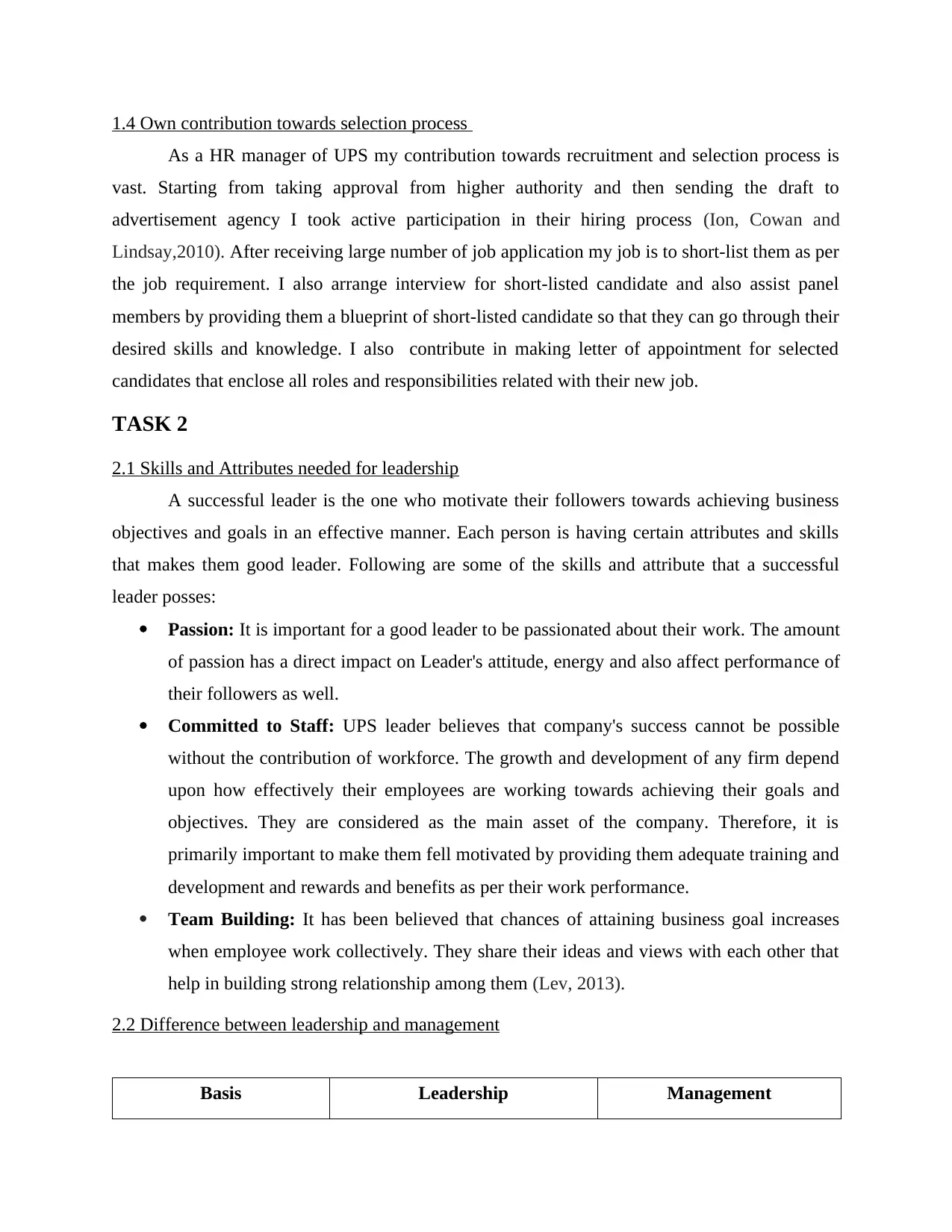
1.4 Own contribution towards selection process
As a HR manager of UPS my contribution towards recruitment and selection process is
vast. Starting from taking approval from higher authority and then sending the draft to
advertisement agency I took active participation in their hiring process (Ion, Cowan and
Lindsay,2010). After receiving large number of job application my job is to short-list them as per
the job requirement. I also arrange interview for short-listed candidate and also assist panel
members by providing them a blueprint of short-listed candidate so that they can go through their
desired skills and knowledge. I also contribute in making letter of appointment for selected
candidates that enclose all roles and responsibilities related with their new job.
TASK 2
2.1 Skills and Attributes needed for leadership
A successful leader is the one who motivate their followers towards achieving business
objectives and goals in an effective manner. Each person is having certain attributes and skills
that makes them good leader. Following are some of the skills and attribute that a successful
leader posses:
Passion: It is important for a good leader to be passionated about their work. The amount
of passion has a direct impact on Leader's attitude, energy and also affect performance of
their followers as well.
Committed to Staff: UPS leader believes that company's success cannot be possible
without the contribution of workforce. The growth and development of any firm depend
upon how effectively their employees are working towards achieving their goals and
objectives. They are considered as the main asset of the company. Therefore, it is
primarily important to make them fell motivated by providing them adequate training and
development and rewards and benefits as per their work performance.
Team Building: It has been believed that chances of attaining business goal increases
when employee work collectively. They share their ideas and views with each other that
help in building strong relationship among them (Lev, 2013).
2.2 Difference between leadership and management
Basis Leadership Management
As a HR manager of UPS my contribution towards recruitment and selection process is
vast. Starting from taking approval from higher authority and then sending the draft to
advertisement agency I took active participation in their hiring process (Ion, Cowan and
Lindsay,2010). After receiving large number of job application my job is to short-list them as per
the job requirement. I also arrange interview for short-listed candidate and also assist panel
members by providing them a blueprint of short-listed candidate so that they can go through their
desired skills and knowledge. I also contribute in making letter of appointment for selected
candidates that enclose all roles and responsibilities related with their new job.
TASK 2
2.1 Skills and Attributes needed for leadership
A successful leader is the one who motivate their followers towards achieving business
objectives and goals in an effective manner. Each person is having certain attributes and skills
that makes them good leader. Following are some of the skills and attribute that a successful
leader posses:
Passion: It is important for a good leader to be passionated about their work. The amount
of passion has a direct impact on Leader's attitude, energy and also affect performance of
their followers as well.
Committed to Staff: UPS leader believes that company's success cannot be possible
without the contribution of workforce. The growth and development of any firm depend
upon how effectively their employees are working towards achieving their goals and
objectives. They are considered as the main asset of the company. Therefore, it is
primarily important to make them fell motivated by providing them adequate training and
development and rewards and benefits as per their work performance.
Team Building: It has been believed that chances of attaining business goal increases
when employee work collectively. They share their ideas and views with each other that
help in building strong relationship among them (Lev, 2013).
2.2 Difference between leadership and management
Basis Leadership Management
Paraphrase This Document
Need a fresh take? Get an instant paraphrase of this document with our AI Paraphraser
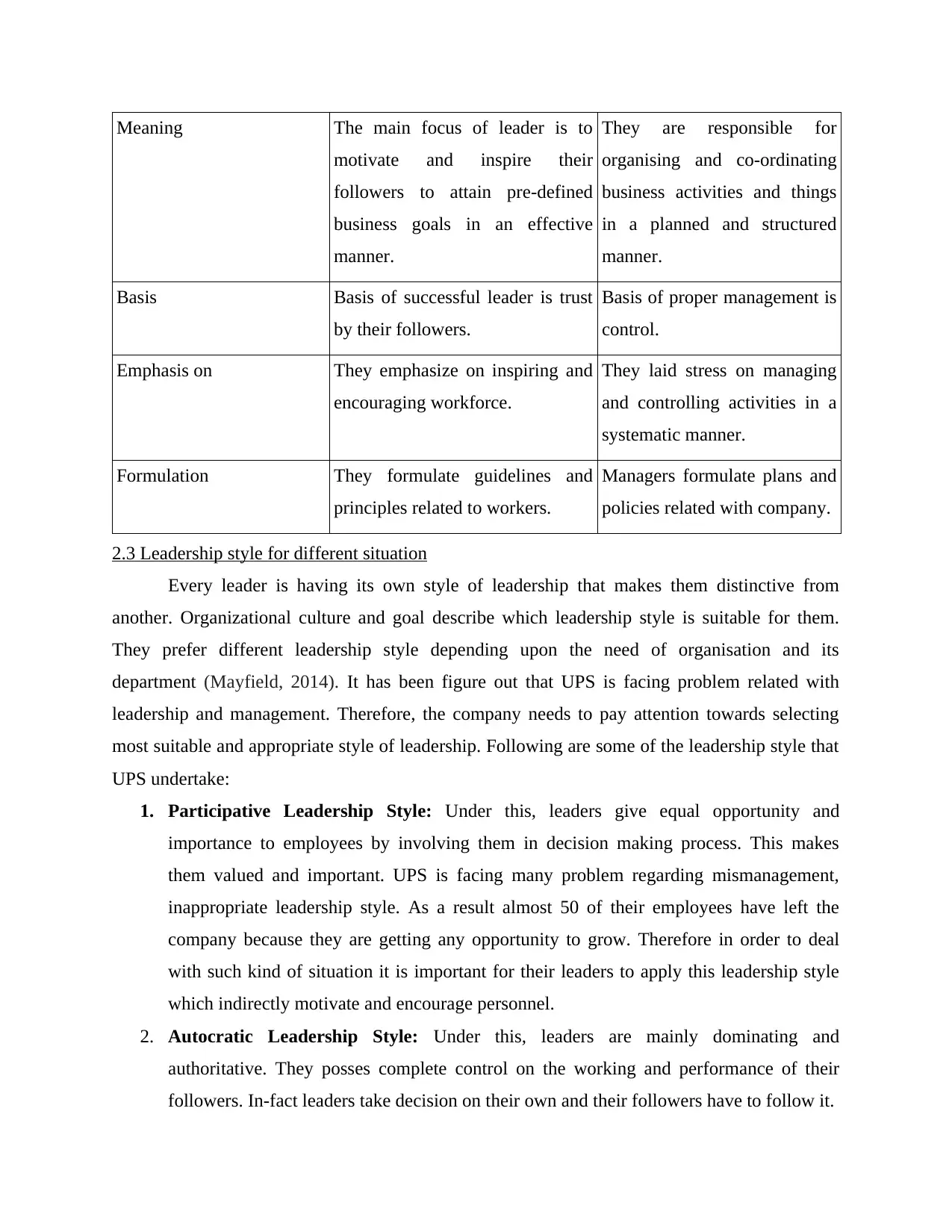
Meaning The main focus of leader is to
motivate and inspire their
followers to attain pre-defined
business goals in an effective
manner.
They are responsible for
organising and co-ordinating
business activities and things
in a planned and structured
manner.
Basis Basis of successful leader is trust
by their followers.
Basis of proper management is
control.
Emphasis on They emphasize on inspiring and
encouraging workforce.
They laid stress on managing
and controlling activities in a
systematic manner.
Formulation They formulate guidelines and
principles related to workers.
Managers formulate plans and
policies related with company.
2.3 Leadership style for different situation
Every leader is having its own style of leadership that makes them distinctive from
another. Organizational culture and goal describe which leadership style is suitable for them.
They prefer different leadership style depending upon the need of organisation and its
department (Mayfield, 2014). It has been figure out that UPS is facing problem related with
leadership and management. Therefore, the company needs to pay attention towards selecting
most suitable and appropriate style of leadership. Following are some of the leadership style that
UPS undertake:
1. Participative Leadership Style: Under this, leaders give equal opportunity and
importance to employees by involving them in decision making process. This makes
them valued and important. UPS is facing many problem regarding mismanagement,
inappropriate leadership style. As a result almost 50 of their employees have left the
company because they are getting any opportunity to grow. Therefore in order to deal
with such kind of situation it is important for their leaders to apply this leadership style
which indirectly motivate and encourage personnel.
2. Autocratic Leadership Style: Under this, leaders are mainly dominating and
authoritative. They posses complete control on the working and performance of their
followers. In-fact leaders take decision on their own and their followers have to follow it.
motivate and inspire their
followers to attain pre-defined
business goals in an effective
manner.
They are responsible for
organising and co-ordinating
business activities and things
in a planned and structured
manner.
Basis Basis of successful leader is trust
by their followers.
Basis of proper management is
control.
Emphasis on They emphasize on inspiring and
encouraging workforce.
They laid stress on managing
and controlling activities in a
systematic manner.
Formulation They formulate guidelines and
principles related to workers.
Managers formulate plans and
policies related with company.
2.3 Leadership style for different situation
Every leader is having its own style of leadership that makes them distinctive from
another. Organizational culture and goal describe which leadership style is suitable for them.
They prefer different leadership style depending upon the need of organisation and its
department (Mayfield, 2014). It has been figure out that UPS is facing problem related with
leadership and management. Therefore, the company needs to pay attention towards selecting
most suitable and appropriate style of leadership. Following are some of the leadership style that
UPS undertake:
1. Participative Leadership Style: Under this, leaders give equal opportunity and
importance to employees by involving them in decision making process. This makes
them valued and important. UPS is facing many problem regarding mismanagement,
inappropriate leadership style. As a result almost 50 of their employees have left the
company because they are getting any opportunity to grow. Therefore in order to deal
with such kind of situation it is important for their leaders to apply this leadership style
which indirectly motivate and encourage personnel.
2. Autocratic Leadership Style: Under this, leaders are mainly dominating and
authoritative. They posses complete control on the working and performance of their
followers. In-fact leaders take decision on their own and their followers have to follow it.
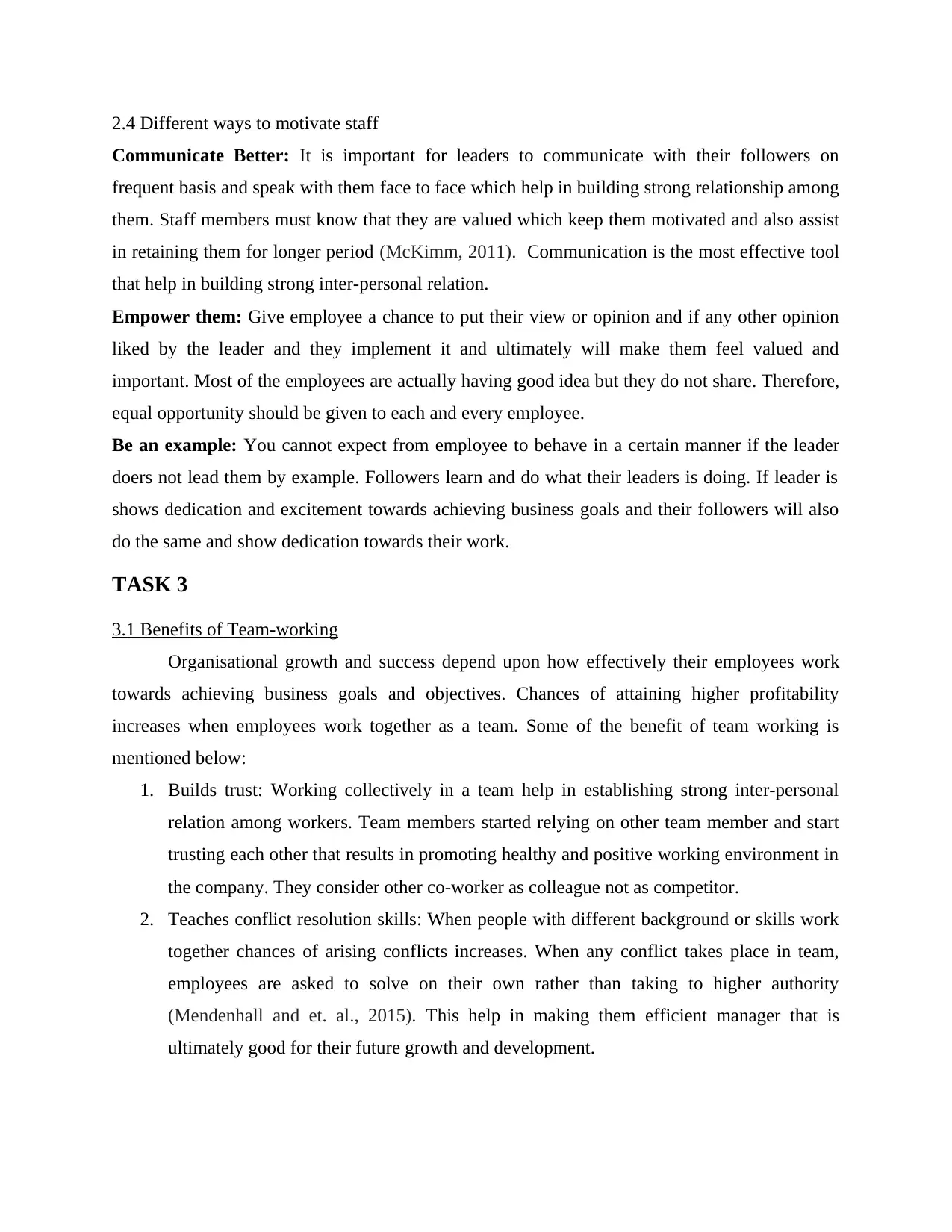
2.4 Different ways to motivate staff
Communicate Better: It is important for leaders to communicate with their followers on
frequent basis and speak with them face to face which help in building strong relationship among
them. Staff members must know that they are valued which keep them motivated and also assist
in retaining them for longer period (McKimm, 2011). Communication is the most effective tool
that help in building strong inter-personal relation.
Empower them: Give employee a chance to put their view or opinion and if any other opinion
liked by the leader and they implement it and ultimately will make them feel valued and
important. Most of the employees are actually having good idea but they do not share. Therefore,
equal opportunity should be given to each and every employee.
Be an example: You cannot expect from employee to behave in a certain manner if the leader
doers not lead them by example. Followers learn and do what their leaders is doing. If leader is
shows dedication and excitement towards achieving business goals and their followers will also
do the same and show dedication towards their work.
TASK 3
3.1 Benefits of Team-working
Organisational growth and success depend upon how effectively their employees work
towards achieving business goals and objectives. Chances of attaining higher profitability
increases when employees work together as a team. Some of the benefit of team working is
mentioned below:
1. Builds trust: Working collectively in a team help in establishing strong inter-personal
relation among workers. Team members started relying on other team member and start
trusting each other that results in promoting healthy and positive working environment in
the company. They consider other co-worker as colleague not as competitor.
2. Teaches conflict resolution skills: When people with different background or skills work
together chances of arising conflicts increases. When any conflict takes place in team,
employees are asked to solve on their own rather than taking to higher authority
(Mendenhall and et. al., 2015). This help in making them efficient manager that is
ultimately good for their future growth and development.
Communicate Better: It is important for leaders to communicate with their followers on
frequent basis and speak with them face to face which help in building strong relationship among
them. Staff members must know that they are valued which keep them motivated and also assist
in retaining them for longer period (McKimm, 2011). Communication is the most effective tool
that help in building strong inter-personal relation.
Empower them: Give employee a chance to put their view or opinion and if any other opinion
liked by the leader and they implement it and ultimately will make them feel valued and
important. Most of the employees are actually having good idea but they do not share. Therefore,
equal opportunity should be given to each and every employee.
Be an example: You cannot expect from employee to behave in a certain manner if the leader
doers not lead them by example. Followers learn and do what their leaders is doing. If leader is
shows dedication and excitement towards achieving business goals and their followers will also
do the same and show dedication towards their work.
TASK 3
3.1 Benefits of Team-working
Organisational growth and success depend upon how effectively their employees work
towards achieving business goals and objectives. Chances of attaining higher profitability
increases when employees work together as a team. Some of the benefit of team working is
mentioned below:
1. Builds trust: Working collectively in a team help in establishing strong inter-personal
relation among workers. Team members started relying on other team member and start
trusting each other that results in promoting healthy and positive working environment in
the company. They consider other co-worker as colleague not as competitor.
2. Teaches conflict resolution skills: When people with different background or skills work
together chances of arising conflicts increases. When any conflict takes place in team,
employees are asked to solve on their own rather than taking to higher authority
(Mendenhall and et. al., 2015). This help in making them efficient manager that is
ultimately good for their future growth and development.
⊘ This is a preview!⊘
Do you want full access?
Subscribe today to unlock all pages.

Trusted by 1+ million students worldwide
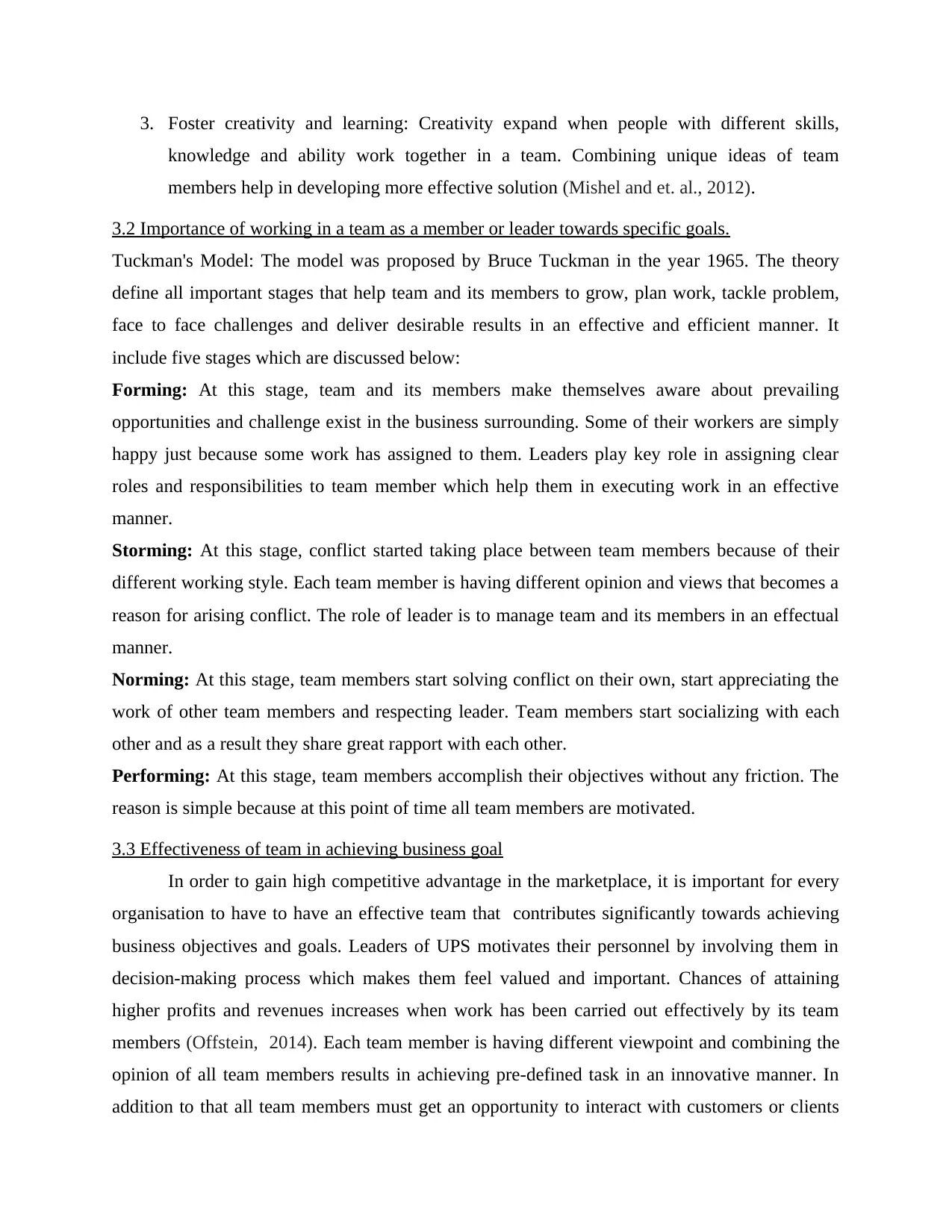
3. Foster creativity and learning: Creativity expand when people with different skills,
knowledge and ability work together in a team. Combining unique ideas of team
members help in developing more effective solution (Mishel and et. al., 2012).
3.2 Importance of working in a team as a member or leader towards specific goals.
Tuckman's Model: The model was proposed by Bruce Tuckman in the year 1965. The theory
define all important stages that help team and its members to grow, plan work, tackle problem,
face to face challenges and deliver desirable results in an effective and efficient manner. It
include five stages which are discussed below:
Forming: At this stage, team and its members make themselves aware about prevailing
opportunities and challenge exist in the business surrounding. Some of their workers are simply
happy just because some work has assigned to them. Leaders play key role in assigning clear
roles and responsibilities to team member which help them in executing work in an effective
manner.
Storming: At this stage, conflict started taking place between team members because of their
different working style. Each team member is having different opinion and views that becomes a
reason for arising conflict. The role of leader is to manage team and its members in an effectual
manner.
Norming: At this stage, team members start solving conflict on their own, start appreciating the
work of other team members and respecting leader. Team members start socializing with each
other and as a result they share great rapport with each other.
Performing: At this stage, team members accomplish their objectives without any friction. The
reason is simple because at this point of time all team members are motivated.
3.3 Effectiveness of team in achieving business goal
In order to gain high competitive advantage in the marketplace, it is important for every
organisation to have to have an effective team that contributes significantly towards achieving
business objectives and goals. Leaders of UPS motivates their personnel by involving them in
decision-making process which makes them feel valued and important. Chances of attaining
higher profits and revenues increases when work has been carried out effectively by its team
members (Offstein, 2014). Each team member is having different viewpoint and combining the
opinion of all team members results in achieving pre-defined task in an innovative manner. In
addition to that all team members must get an opportunity to interact with customers or clients
knowledge and ability work together in a team. Combining unique ideas of team
members help in developing more effective solution (Mishel and et. al., 2012).
3.2 Importance of working in a team as a member or leader towards specific goals.
Tuckman's Model: The model was proposed by Bruce Tuckman in the year 1965. The theory
define all important stages that help team and its members to grow, plan work, tackle problem,
face to face challenges and deliver desirable results in an effective and efficient manner. It
include five stages which are discussed below:
Forming: At this stage, team and its members make themselves aware about prevailing
opportunities and challenge exist in the business surrounding. Some of their workers are simply
happy just because some work has assigned to them. Leaders play key role in assigning clear
roles and responsibilities to team member which help them in executing work in an effective
manner.
Storming: At this stage, conflict started taking place between team members because of their
different working style. Each team member is having different opinion and views that becomes a
reason for arising conflict. The role of leader is to manage team and its members in an effectual
manner.
Norming: At this stage, team members start solving conflict on their own, start appreciating the
work of other team members and respecting leader. Team members start socializing with each
other and as a result they share great rapport with each other.
Performing: At this stage, team members accomplish their objectives without any friction. The
reason is simple because at this point of time all team members are motivated.
3.3 Effectiveness of team in achieving business goal
In order to gain high competitive advantage in the marketplace, it is important for every
organisation to have to have an effective team that contributes significantly towards achieving
business objectives and goals. Leaders of UPS motivates their personnel by involving them in
decision-making process which makes them feel valued and important. Chances of attaining
higher profits and revenues increases when work has been carried out effectively by its team
members (Offstein, 2014). Each team member is having different viewpoint and combining the
opinion of all team members results in achieving pre-defined task in an innovative manner. In
addition to that all team members must get an opportunity to interact with customers or clients
Paraphrase This Document
Need a fresh take? Get an instant paraphrase of this document with our AI Paraphraser
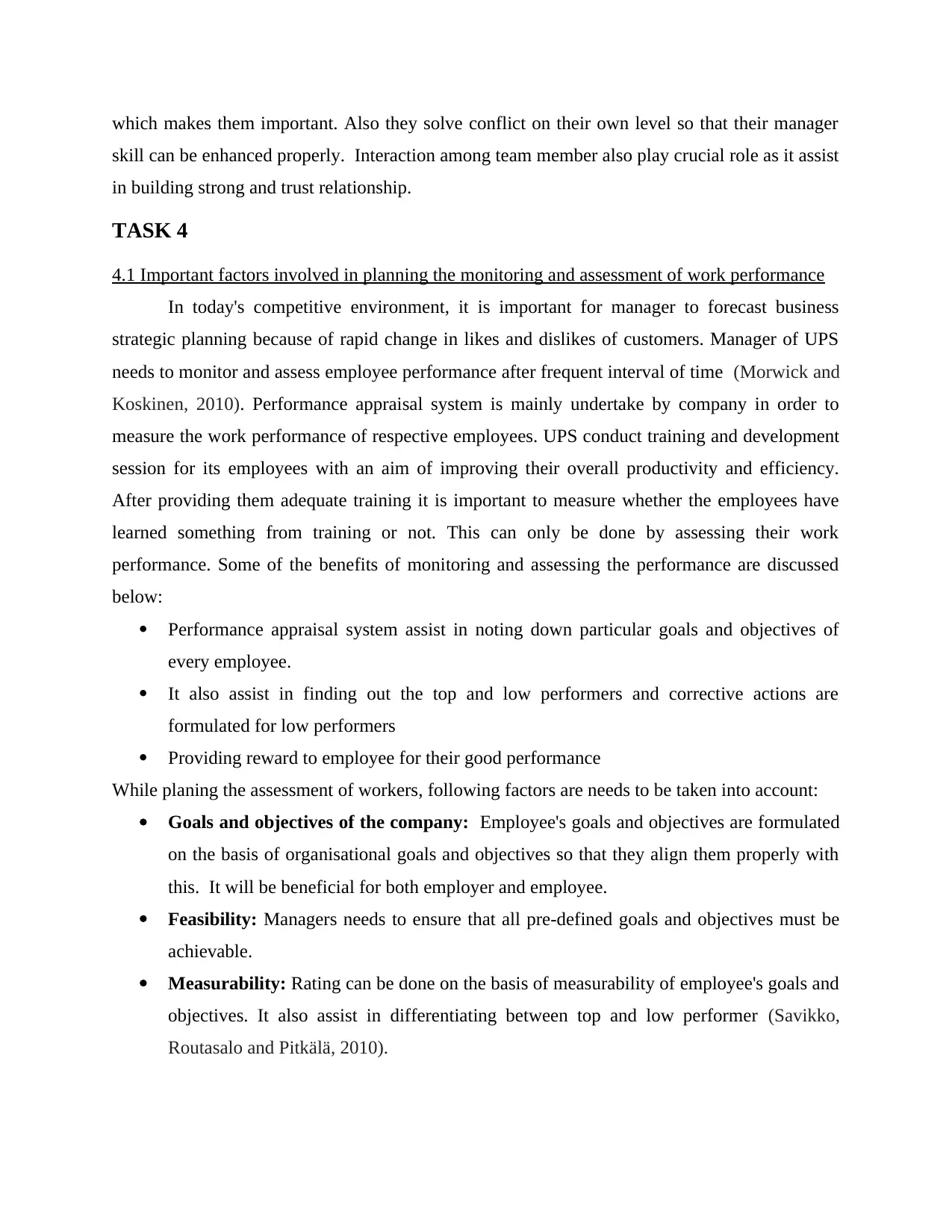
which makes them important. Also they solve conflict on their own level so that their manager
skill can be enhanced properly. Interaction among team member also play crucial role as it assist
in building strong and trust relationship.
TASK 4
4.1 Important factors involved in planning the monitoring and assessment of work performance
In today's competitive environment, it is important for manager to forecast business
strategic planning because of rapid change in likes and dislikes of customers. Manager of UPS
needs to monitor and assess employee performance after frequent interval of time (Morwick and
Koskinen, 2010). Performance appraisal system is mainly undertake by company in order to
measure the work performance of respective employees. UPS conduct training and development
session for its employees with an aim of improving their overall productivity and efficiency.
After providing them adequate training it is important to measure whether the employees have
learned something from training or not. This can only be done by assessing their work
performance. Some of the benefits of monitoring and assessing the performance are discussed
below:
Performance appraisal system assist in noting down particular goals and objectives of
every employee.
It also assist in finding out the top and low performers and corrective actions are
formulated for low performers
Providing reward to employee for their good performance
While planing the assessment of workers, following factors are needs to be taken into account:
Goals and objectives of the company: Employee's goals and objectives are formulated
on the basis of organisational goals and objectives so that they align them properly with
this. It will be beneficial for both employer and employee.
Feasibility: Managers needs to ensure that all pre-defined goals and objectives must be
achievable.
Measurability: Rating can be done on the basis of measurability of employee's goals and
objectives. It also assist in differentiating between top and low performer (Savikko,
Routasalo and Pitkälä, 2010).
skill can be enhanced properly. Interaction among team member also play crucial role as it assist
in building strong and trust relationship.
TASK 4
4.1 Important factors involved in planning the monitoring and assessment of work performance
In today's competitive environment, it is important for manager to forecast business
strategic planning because of rapid change in likes and dislikes of customers. Manager of UPS
needs to monitor and assess employee performance after frequent interval of time (Morwick and
Koskinen, 2010). Performance appraisal system is mainly undertake by company in order to
measure the work performance of respective employees. UPS conduct training and development
session for its employees with an aim of improving their overall productivity and efficiency.
After providing them adequate training it is important to measure whether the employees have
learned something from training or not. This can only be done by assessing their work
performance. Some of the benefits of monitoring and assessing the performance are discussed
below:
Performance appraisal system assist in noting down particular goals and objectives of
every employee.
It also assist in finding out the top and low performers and corrective actions are
formulated for low performers
Providing reward to employee for their good performance
While planing the assessment of workers, following factors are needs to be taken into account:
Goals and objectives of the company: Employee's goals and objectives are formulated
on the basis of organisational goals and objectives so that they align them properly with
this. It will be beneficial for both employer and employee.
Feasibility: Managers needs to ensure that all pre-defined goals and objectives must be
achievable.
Measurability: Rating can be done on the basis of measurability of employee's goals and
objectives. It also assist in differentiating between top and low performer (Savikko,
Routasalo and Pitkälä, 2010).
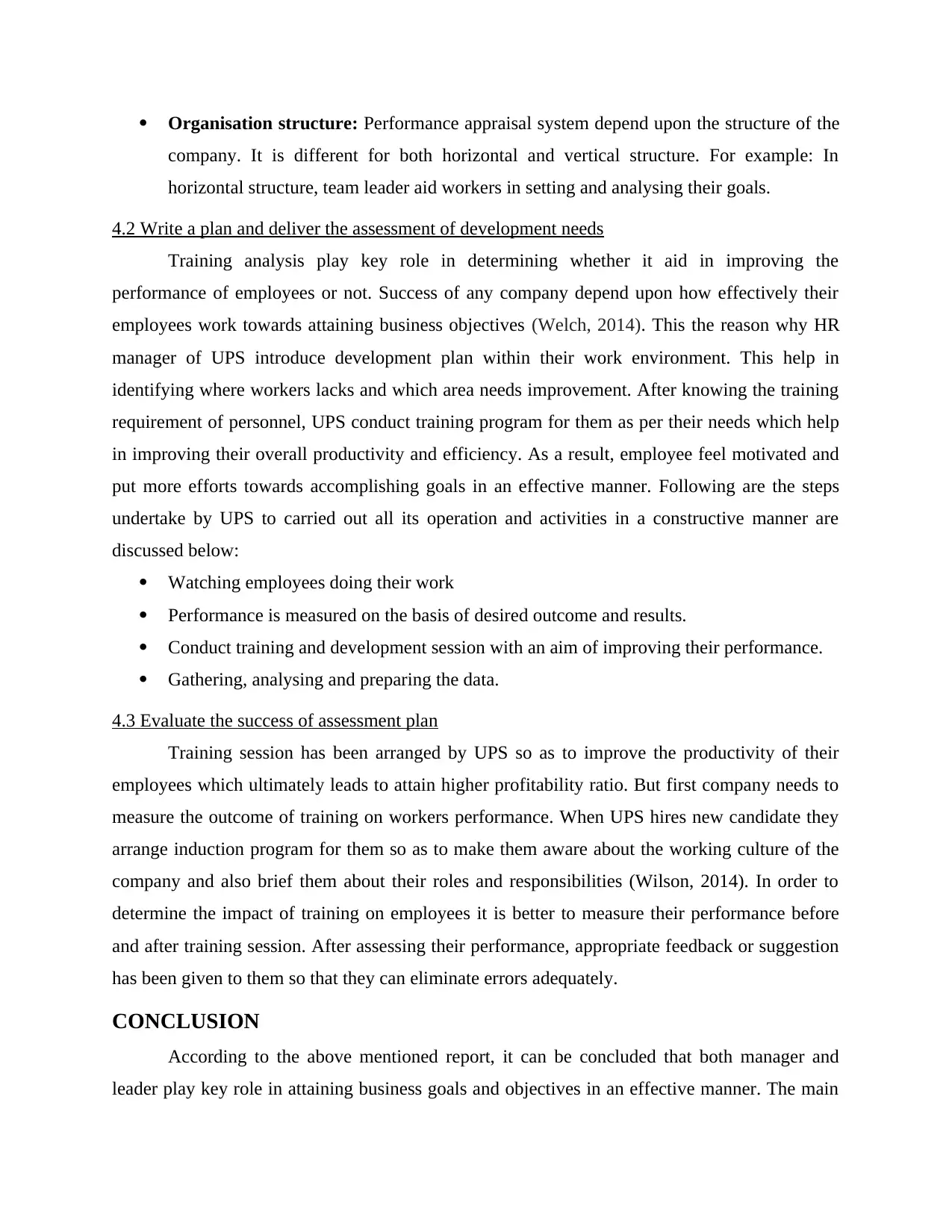
Organisation structure: Performance appraisal system depend upon the structure of the
company. It is different for both horizontal and vertical structure. For example: In
horizontal structure, team leader aid workers in setting and analysing their goals.
4.2 Write a plan and deliver the assessment of development needs
Training analysis play key role in determining whether it aid in improving the
performance of employees or not. Success of any company depend upon how effectively their
employees work towards attaining business objectives (Welch, 2014). This the reason why HR
manager of UPS introduce development plan within their work environment. This help in
identifying where workers lacks and which area needs improvement. After knowing the training
requirement of personnel, UPS conduct training program for them as per their needs which help
in improving their overall productivity and efficiency. As a result, employee feel motivated and
put more efforts towards accomplishing goals in an effective manner. Following are the steps
undertake by UPS to carried out all its operation and activities in a constructive manner are
discussed below:
Watching employees doing their work
Performance is measured on the basis of desired outcome and results.
Conduct training and development session with an aim of improving their performance.
Gathering, analysing and preparing the data.
4.3 Evaluate the success of assessment plan
Training session has been arranged by UPS so as to improve the productivity of their
employees which ultimately leads to attain higher profitability ratio. But first company needs to
measure the outcome of training on workers performance. When UPS hires new candidate they
arrange induction program for them so as to make them aware about the working culture of the
company and also brief them about their roles and responsibilities (Wilson, 2014). In order to
determine the impact of training on employees it is better to measure their performance before
and after training session. After assessing their performance, appropriate feedback or suggestion
has been given to them so that they can eliminate errors adequately.
CONCLUSION
According to the above mentioned report, it can be concluded that both manager and
leader play key role in attaining business goals and objectives in an effective manner. The main
company. It is different for both horizontal and vertical structure. For example: In
horizontal structure, team leader aid workers in setting and analysing their goals.
4.2 Write a plan and deliver the assessment of development needs
Training analysis play key role in determining whether it aid in improving the
performance of employees or not. Success of any company depend upon how effectively their
employees work towards attaining business objectives (Welch, 2014). This the reason why HR
manager of UPS introduce development plan within their work environment. This help in
identifying where workers lacks and which area needs improvement. After knowing the training
requirement of personnel, UPS conduct training program for them as per their needs which help
in improving their overall productivity and efficiency. As a result, employee feel motivated and
put more efforts towards accomplishing goals in an effective manner. Following are the steps
undertake by UPS to carried out all its operation and activities in a constructive manner are
discussed below:
Watching employees doing their work
Performance is measured on the basis of desired outcome and results.
Conduct training and development session with an aim of improving their performance.
Gathering, analysing and preparing the data.
4.3 Evaluate the success of assessment plan
Training session has been arranged by UPS so as to improve the productivity of their
employees which ultimately leads to attain higher profitability ratio. But first company needs to
measure the outcome of training on workers performance. When UPS hires new candidate they
arrange induction program for them so as to make them aware about the working culture of the
company and also brief them about their roles and responsibilities (Wilson, 2014). In order to
determine the impact of training on employees it is better to measure their performance before
and after training session. After assessing their performance, appropriate feedback or suggestion
has been given to them so that they can eliminate errors adequately.
CONCLUSION
According to the above mentioned report, it can be concluded that both manager and
leader play key role in attaining business goals and objectives in an effective manner. The main
⊘ This is a preview!⊘
Do you want full access?
Subscribe today to unlock all pages.

Trusted by 1+ million students worldwide
1 out of 15
Related Documents
Your All-in-One AI-Powered Toolkit for Academic Success.
+13062052269
info@desklib.com
Available 24*7 on WhatsApp / Email
![[object Object]](/_next/static/media/star-bottom.7253800d.svg)
Unlock your academic potential
Copyright © 2020–2025 A2Z Services. All Rights Reserved. Developed and managed by ZUCOL.




